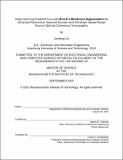| dc.contributor.advisor | Fujimoto, James G. | |
| dc.contributor.author | Lin, Junhong | |
| dc.date.accessioned | 2023-01-19T19:50:54Z | |
| dc.date.available | 2023-01-19T19:50:54Z | |
| dc.date.issued | 2022-09 | |
| dc.date.submitted | 2022-10-19T18:57:45.712Z | |
| dc.identifier.uri | https://hdl.handle.net/1721.1/147445 | |
| dc.description.abstract | Aged-related macular degeneration (AMD) and diabetic retinopathy (DR), the leading cause of significant vision loss worldwide, alter the retinal structure and capillary blood flow in eyes. Optical coherence tomography (OCT) and angiography (OCTA), the gold standard imaging modalities in ophthalmic clinics, enable the micrometer-scale visualization of retinal structure and vasculature and provide the ability for early detection and progression monitoring of retinal disease. Ultrahigh resolution, spectral domain OCT prototype (UHR SD-OCT) and ultrahigh speed, swept source OCT prototype (UHS SS-OCT) developed by our group provide the ability to visualize the fine structural changes in the outer retina and vascular changes in the retina respectively, which occur with the disease progression. A few of the most important clinical findings with AMD and DR, such as drusen and choriocapillaris (CC) blood flow deficit, are located adjacent to the Bruch’s membrane (BrM). BrM is a very thin (2–6 µm) extracellular matrix, which is generally not resolved in commercial OCT instrument and therefore challenging to perform segmentation and analysis. It is even more challenging when pathologic changes in retina distort its appearance and contrast. To qualitatively and quantitatively assess the pathologic changes adjacent to BrM, an accurate segmentation is required for robust analysis. This thesis presents an advanced automatic, deep learning-based segmentation framework. The study aims to generate an accurate BrM segmentation for quantitative analysis. The performance of the segmentation is evaluated on both healthy eyes and eyes with retinal diseases, and reproducibility / repeatability is assessed through consecutive repeated imaging sessions on patients as well as longitudinal imaging of patients. This study will facilitate the investigation of in vivo early structural / vascular biomarker for AMD and DR progression. | |
| dc.publisher | Massachusetts Institute of Technology | |
| dc.rights | In Copyright - Educational Use Permitted | |
| dc.rights | Copyright MIT | |
| dc.rights.uri | http://rightsstatements.org/page/InC-EDU/1.0/ | |
| dc.title | Deep-learning Enabled Accurate Bruch’s Membrane Segmentation in Ultrahigh-Resolution Spectral Domain and Ultrahigh-Speed Swept Source Optical Coherence Tomography | |
| dc.type | Thesis | |
| dc.description.degree | S.M. | |
| dc.contributor.department | Massachusetts Institute of Technology. Department of Electrical Engineering and Computer Science | |
| mit.thesis.degree | Master | |
| thesis.degree.name | Master of Science in Electrical Engineering and Computer Science | |
